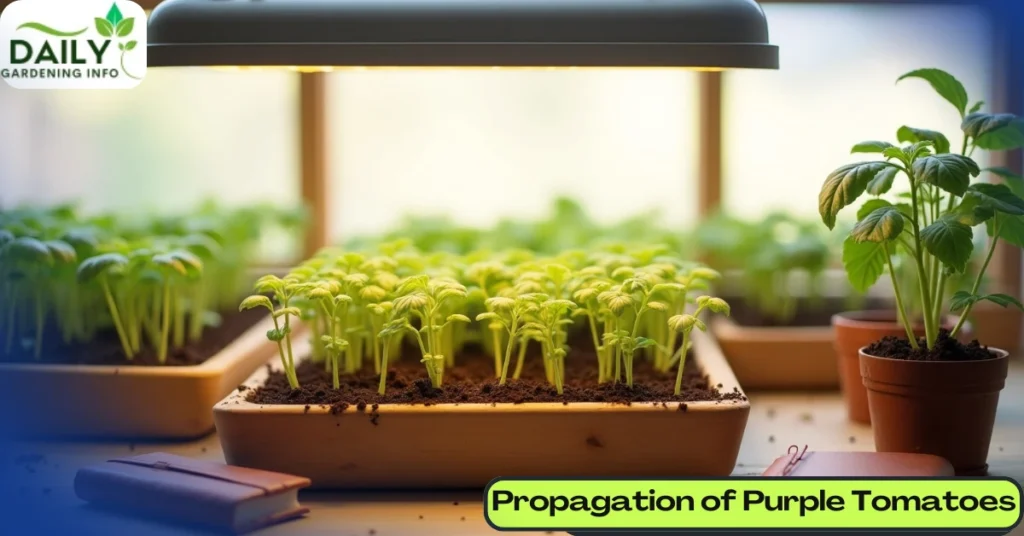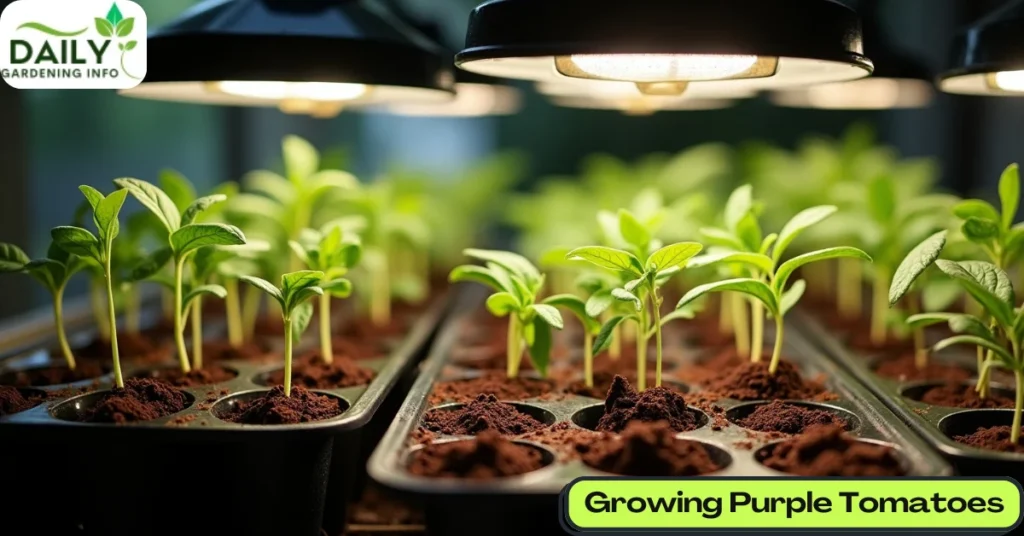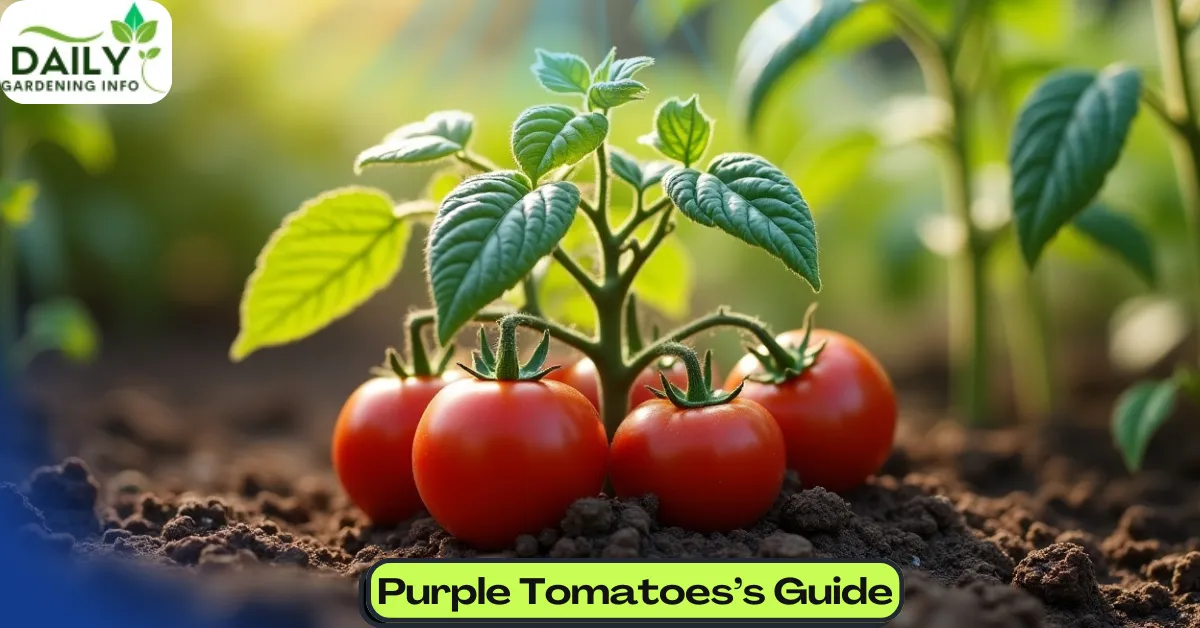Purple tomatoes bring a fresh twist to the usual red ones. They stand out with bright colors, tasty flavors, and great health perks. This simple guide looks at different purple tomato varieties, shares easy tips for growing purple tomatoes, tackles common growing problems, suggests fun purple tomato recipes, and explains the health benefits of purple tomatoes. Plus, it shows how these tomatoes add beauty to your garden and goodness to your meals, giving you everything you need to enjoy them fully.
Advantages of Cultivating Purple Tomatoes
Purple tomatoes offer more than aesthetic appeal. They deliver substantial health benefits. The deep purple hue derives from anthocyanins, potent antioxidants that neutralize free radicals. These compounds reduce inflammation and protect cellular integrity. Additionally, purple tomatoes exhibit a distinctive smoky-sweet taste. Their cultivation is easy, rendering them an accessible option for gardeners seeking both novelty and nourishment.
Notable Purple Tomato Varieties
Cherokee Purple
Cherokee Purple tomatoes constitute a revered heirloom cultivar. Originating over a century ago with the Cherokee tribe, they feature a reddish-purple exterior and a complex, sweet flavor. These tomatoes excel when sliced for sandwiches or incorporated into salads. Cultivation requires full sunlight—6 to 8 hours daily—and well-draining soil. Plants should be spaced 2 to 3 feet apart for optimal development.
Indigo Rose
Indigo Rose tomatoes are characterized by their nearly black skin. Rich in anthocyanins, they support cardiovascular health. These smaller fruits, weighing 2 to 3 ounces, offer a tangy-sweet taste and abundant Vitamin C. They enhance salads or serve as garnishes. Successful growth demands full sunlight and nutrient-rich soil.
Purple-Black Heirloom and Hybrids
Additional purple tomato varieties include Purple-Black Heirlooms and hybrids such as Black Krim. Each provides unique flavor profiles and sizes, suitable for sauces, salsas, or fresh consumption. Their vivid pigmentation reflects high nutrient content, making them valuable additions to any garden.
Purple Bumble Bee
Purple Bumble Bee tomatoes are diminutive, cherry-type fruits with purple and green striations. Their sweet, juicy nature suits snacking or garnishing. These adaptable plants thrive in containers or garden beds, provided they receive ample sunlight and proper drainage.

Optimal Conditions for Growing Purple Tomatoes
Sunlight Requirements
Purple tomatoes necessitate 6 to 8 hours of direct sunlight daily. This exposure ensures vigorous growth and abundant fruit production. A south-facing location is recommended. For indoor cultivation, supplementary grow lights are essential to maintain light levels.
Watering Needs
Consistent moisture is critical, with 1 to 2 inches of water required weekly. Irrigation should target the base to prevent foliar diseases. Mulching with organic materials, such as compost, preserves soil moisture and mitigates evaporation during warm periods.
Soil Quality
Purple tomatoes flourish in well-draining, fertile soil. Incorporation of compost or aged manure enhances nutrient availability. A soil pH of 6.0 to 6.8 is ideal for nutrient uptake. Regular soil testing prevents deficiencies that impair plant vigor.
Temperature Preferences
Daytime temperatures between 70°F and 85°F (21°C to 29°C) are optimal. Nighttime temperatures should exceed 55°F (13°C) to encourage flowering. Protection from excessive heat above 90°F (32°C) may involve shade cloth, while cooler climates benefit from greenhouse structures.
Detailed Propagation of Purple Tomatoes in 10 Steps
- Select Propagation Method: Seeds are preferred for novice gardeners. Purple tomato seeds exhibit a germination rate of 70% to 90%, ensuring reliable results.
- Assemble Materials: High-quality heirloom seeds, such as Cherokee Purple or Brandywine, are recommended. A light seed-starting medium, trays, and a fine-mist sprayer are necessary tools.
- Prepare Containers: Fill trays with pre-moistened seed-starting medium. This ensures immediate seed-to-soil contact, facilitating germination.
- Sow Seeds: Plant seeds at a depth of ¼ inch. Place 2 to 3 seeds per cell and cover lightly with soil to avoid impeding emergence.
- Maintain Temperature: Position trays in an environment of 70°F to 80°F (21°C to 27°C). A heating mat may be employed to sustain warmth, accelerating germination.
- Provide Illumination: Upon sprouting, ensure 12 to 16 hours of light daily. Natural sunlight or artificial grow lights suffice. Insufficient light compromises seedling strength.
- Regulate Moisture: Apply a fine mist to maintain consistent soil moisture. Excess water risks root rot, while inadequate hydration delays growth.
- Thin Seedlings: When seedlings develop 2 to 3 true leaves, remove weaker specimens. Retain one robust plant per cell to eliminate competition.
- Enhance Nutrition: Administer a diluted organic fertilizer, such as compost tea, at the two-leaf stage. This supports early vigor without overwhelming young roots.
- Transplant Outdoors: Relocate seedlings measuring 6 to 8 inches after the final frost. Gradually acclimate them to outdoor conditions over 1 to 2 weeks, beginning with brief exposure.

Practical Advice for Growing Purple Tomatoes
Seed Selection and Germination
Superior purple tomato seeds are foundational. Commence germination indoors 6 to 8 weeks prior to the last frost. Controlled warmth and ample light promote successful sprouting.
Soil Preparation
Soil must be nutrient-rich and well-draining. A pH range of 6.0 to 6.8 optimizes growth. Incorporate 2 to 3 inches of organic compost to enhance fertility and structure.
Planting Techniques
Transplant seedlings outdoors following the frost season. Allocate 24 to 36 inches between plants. Ensure 6 to 8 hours of sunlight daily. Water at the base to minimize disease risk.
Structural Support
Purple tomatoes benefit from staking or caging. Their vigorous growth requires support to prevent collapse. Pruning lateral shoots below the first flower directs energy to fruit production.
Fertilization Schedule
Apply a balanced fertilizer every 4 to 6 weeks during the growing season. Over-fertilization may favor foliage over fruit, necessitating moderation.

Common Challenges and Resolutions
Disease Prevention
Purple tomatoes may succumb to blight or rot. Base watering and mulching reduce foliar moisture. These practices inhibit fungal proliferation effectively.
Pest Management
Aphids and caterpillars pose threats. Organic controls, such as neem oil, prove efficacious. Companion planting with marigolds or basil further deters infestations.
Nutrient Deficiencies
Blossom end rot signals calcium insufficiency. Soil amendments, such as gypsum, address this issue. Consistent irrigation prevents recurrence.
Harvesting and Storing Purple Tomatoes
Identifying Ripeness
Harvest purple tomatoes when uniformly deep purple and slightly yielding to pressure. This ensures maximum flavor and quality.
Harvesting Method
Employ pruning shears to remove fruit. This technique preserves plant health and encourages continued production.
Storage Guidelines
Store purple tomatoes at room temperature, shielded from sunlight. Refrigeration diminishes flavor. For extended preservation, consider drying or canning.
Culinary Applications of Purple Tomatoes
Purple tomatoes enhance diverse dishes with their unique attributes:
- Salad Enhancement: Slice purple tomatoes and combine with basil, mozzarella, and olive oil. A pinch of salt elevates the ensemble.
- Salsa Preparation: Dice purple tomatoes with onions, peppers, and herbs. The smoky undertone enriches the mixture.
- Sauce Creation: Roast purple tomatoes with garlic and rosemary. Puree for a refined pasta or pizza topping.
- Grilled Option: Skewer cherry purple tomatoes alongside vegetables. Brief grilling intensifies their sweetness.
Health Benefits of Purple Tomatoes
Purple tomatoes are replete with vitamins A, C, and K, supporting vision, immunity, and skeletal health. Potassium and fiber contribute to cardiovascular wellness. Anthocyanins provide anti-inflammatory and antioxidant effects, potentially mitigating chronic disease risks, including cancer and heart conditions.
Conclusion: The Value of Purple Tomatoes
Purple tomatoes elevate gardens with elegance and nutrition. Cherokee Purple, Indigo Rose, and other purple tomato varieties offer the exceptional flavor and health benefits of purple tomatoes. Their cultivation is both accessible and rewarding. Integrating purple tomatoes into horticultural and culinary practices yields substantial returns in beauty and vitality.

Leave a Reply